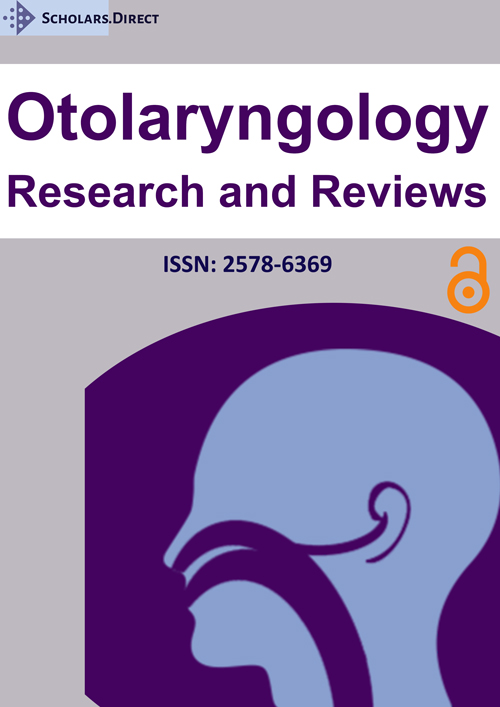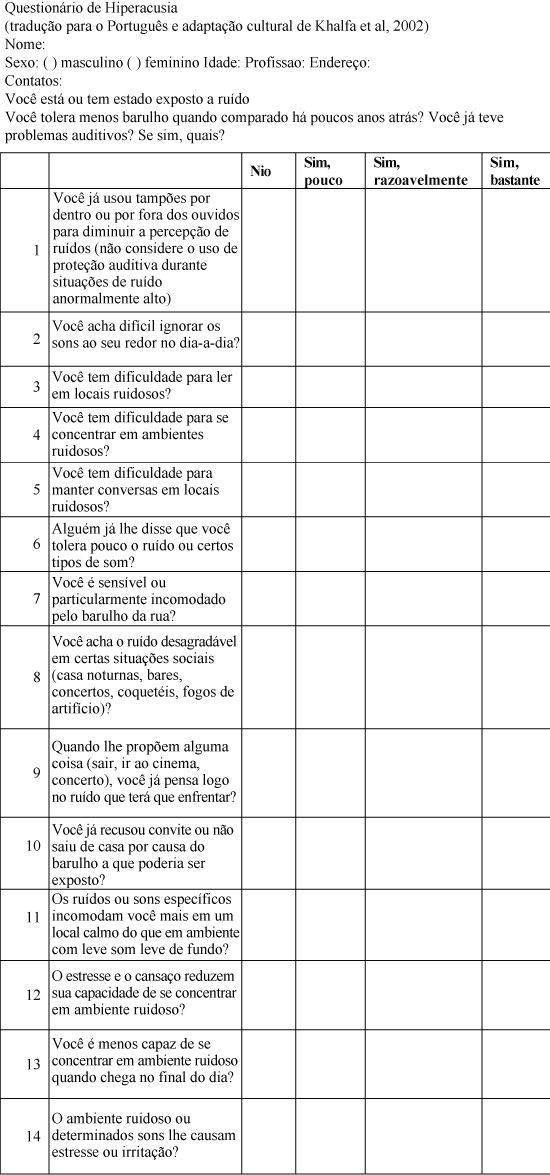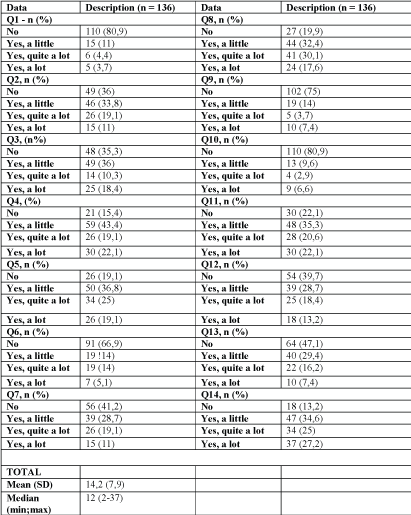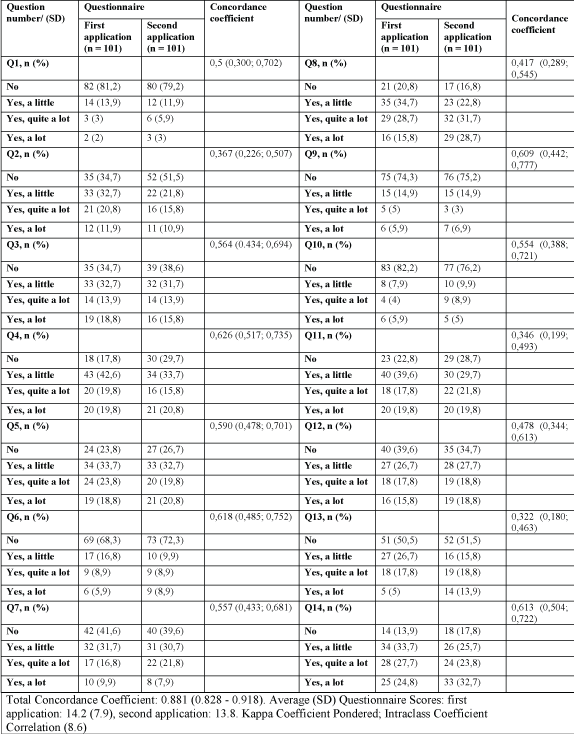Validation of the Portuguese Version of Hyperacusis Questionnaire and Comparison of Diagnostic Skills with Loudness Discomfort Levels
Keywords
Hyperacusis, Questionnaire, Validation, Tinnitus
Abbreviations
HQ: Hyperacusis Questionnaire; LDL: Loudness Discomfort Levels; dB SL: deciBel Sensation Level
Introduction
Hyperacusis is a condition entailing increased sensitivity or unusual intolerance to ordinary environmental sounds that would not usually be bothersome, threatening or uncomfortably loud to most individuals, but cause significant distress and impairment in social activities due to physical discomfort, pain or fear of sounds [1-3]. Such negative reaction is related to the physical characteristics of the sounds, and not to the frequency or quality of sounds [4]. Baguley, et al. considered hyperacusis as a central auditory reaction modulated by emotional states such as fear and anxiety [5] and Tyler, et al. discriminates four clinical components of hyperacusis: Loudness, annoyance, fear and pain [6].
A patient's negative reactions may occur in response to any, including low, level of sound. It is postulated that decreased sound tolerance consists of two components: hyperacusis and misophonia, which frequently occur together [4].
Misophonia is defined as an abnormally strong reaction to a sound with a specific pattern and meaning to a given subject. The physical characteristics of the sound are secondary. Reactions to the sound depend on the subject's past history and on non-auditory factors such as the subject's previous evaluation of the sound, his/her belief that the sound is a potential threat or that exposure to it will be harmful, the subject's psychologic profile, and the context in which the sound is presented [7-9].
This symptom has been demanding growing interest because: 1) Its prevalence reaches 8 to 15% of the population [10,11]; 2) It is associated to hearing loss, tinnitus, autism, migraine and other sensory hypersensitivity disorders [12]; 3) It compromises emotional status, sleep, and concentration [13,14], turning familiar, professional and social lives difficult.
There is enough evidence of a positive correlation between hyperacusis and tinnitus [4,14-17]. Thus, having a reliable measurement of hyperacusis would be of interest for managing patients with one or another symptom [18].
The association of a clinical history of discomfort to different daily sounds and altered measurements of Loudness Discomfort Levels (LDL) is the most acceptable diagnosis of hyperacusis, although results lack standardization [4,18,19]. The thresholds of LDL are decreased in such patients in most frequencies between 500 and 8000 Hz in one or both ears [18-21]. It can be classified as: Mild hyperacusis when LDL is at 80-90 dB in 2 or more frequencies, moderate hyperacusis in presence of LDL at 65-75 dB in 2 or more frequencies and severe hyperacusis in presence of LDL at 60 dB or lower in 2 or more frequencies [19].
Common limitations of measuring LDL are related to the strong dependence on the instruction given. Different instructions may lead to a difference greater than 20 dBHL, therefore the test should be carefully performed [18,22,23] and associated to the clinical history. Moreover, clinical cut-off values of LDL differ among authors (< 90 dBHL [24], < 70 dBHL [18] and between 60-85 dBHL [25]) and test-retest reliability has been questioned [21]. Therefore, the further use of a validated questionnaire might help in standardizing diagnosis, screening the presence of, and establishing severity/impairment levels of hyperacusis.
The Hyperacusis Questionnaire (HQ) was first elaborated by Khalfa, et al. to quantify and characterize hyperacusis [26]. The first part consists of three binary questions that collect information on auditory disorders and noise exposure. The second part consists of 14 questions with a 4-point scale answer each: "no" (0 point), "yes, a little" (1 point), "yes, quite a lot" (2 points), and "yes, a lot" (3 points). Such questions evaluate three major dimensions: Attentional (questions 1-4), social (questions 5-10) and emotional (questions 11-14) with satisfactory internal consistency reliability. The total score ranges from 0 to 42; the higher the score, the greater the hypersensitivity.
The HQ has already been translated into Dutch [27], Italian [28] and Japanese [29] versions that were subsequently validated. Since differences in symptom expression among cultural groups might compromise the validity of the questionnaire [30], we aimed at performing the cross-cultural adaptation and validation of the Portuguese version of HQ, and compared our results to Loudness Discomfort Levels results.
Statistical Analysis
Quantitative personal characteristics and the results of the questionnaires and quantitative scales have been reported in patients using summary measures (mean, standard deviation, median, minimum and maximum) and evaluated qualitative characteristics were described using absolute and relative frequencies [31]. Each issue of hyperacusis questionnaire were described in the two evaluations carried out and evaluated the reproducibility of the questionnaire for each question using the weighted Kappa coefficient with the respective intervals with 95% confidence [32]. The total questionnaire was described in each evaluation and verified the reproducibility of this method with use of the Intraclass Correlation Coefficient (ICC), with its range with 95% confidence [32]. To check the questionnaire construct validation, it was compared between sexes using Mann-Whitney test [31] and verified the correlation with age using Spearman correlation [31]. Internal consistency was verified the questions of the questionnaire and the total with use of Cronbach's alpha [31], each item removed from the questionnaire and evaluated in the presence of other items. The concurrent validity of the questionnaire was tested using Spearman's total questionnaire correlated with assessments at each frequency of LDL and also compared the total questionnaire between categories of LDL classification using the Kruskal-Wallis test, followed by Dunn's multiple comparisons [33]. The tests were performed at the 5% significance level.
Methods
After receiving approval of the Ethics committee of Hospital Universitário of University of São Paulo, this prospective cross-sectional study was conducted in two phases from August 2015 to March 2016:
- Phase 1: Cross-cultural adaptation and validation of the Portuguese version of HQ: This phase was conducted following the criteria established by Guillemin, et al. [30], which consisted of four steps. First step: Two native Portuguese speakers from Brazil, who were bilingual in English and knew the purpose of the study, were asked to independently translate the original questionnaire from English into Brazilian Portuguese after receiving the permission of the author; Second step: Both original and translated versions were analyzed by a team of professionals (two otolaryngologists and one linguistic professor), which led to a final single version that maintained linguistic consistency while keeping the basic characteristics of the concepts of the original questionnaire; Third step: the final version was translated back into English and compared with the original questionnaire by two other native speakers who did not know the purpose of the study; Fourth step: After a critical analysis of the linguist professor that there were no differences between the original and translated versions, we proceeded to the application and reapplication of the final Portuguese version of HQ in a sample of subjects whose data is displayed below. Data on the clinical application and reapplication of HQ was further analyzed for validation of the questionnaire and establishing a cut-off score for diagnosing hyperacusis. The patients answered questionnaires by themselves. We were available to help if they had any issues understanding the items.
- Phase 2: Comparison between results obtained from HQ and Loudness Discomfort Levels (LDL). The sample selected to undergo the fourth step of Phase 1 and Phase 2 included all consecutive patients who spontaneously attended a medical appointment in a tinnitus and hyperacusis center, from November 2015 to March 2016, regardless of their main complaints. They were invited to participate and signed the informed consent. The exclusion criteria were patients under 18-years-old and those who refused to undergo any step of the research. The final sample was composed by 136 subjects (100% Caucasians, 64.7% males, 35.3% females). Age varied from 14-89 years (mean = 49.8 years; SD ± 14.3; median = 49).
All patients were asked by the physician assistant to fill out by themselves the Portuguese version of HQ in the waiting room, before medical consultation starts. If they had any doubt, a physician would help to make unclear questions understandable. Among the 136 patients, 101 (74.2%) answered the questionnaire for the second time after the appointment to check for test-retest reliability. Pure-tone audiometry was performed in an acoustic chamber in frequencies from 0.25-16 kHz. Patients who had tinnitus were further submitted to pitch and loudness matching [34]. Loudness Discomfort Levels (LDLs) were obtained for both ears in frequencies from 0.5-4 kHz. The stimuli were presented from 50 dBHL, ascending in steps of 5 dB [22]. Patients were instructed to indicate when the sound delivered through the earphone from the audiometer became uncomfortable, not just loud. The standardized verbal instruction made by the audiologist was: "You will hear sounds that will become louder. Please, press the button when the sound reaches an intensity that you no longer want to hear it and the sound will stop immediately. We want to know which intensity provokes discomfort and not to know if the sound is strong or weak. The sound can be strong and not provoke any hearing discomfort, for example. This test does not offer risk to your hearing even if you hear a sound in the maximum intensity of this equipment" [22]. Two trials were used for each loudness measure to ensure reliability. We adopted the classification of hyperacusis as suggested by Goldstein and Shulman [19] (Table 1).
The quantitative personal characteristics, results of the questionnaires and quantitative scales were statistically reported using summary measures (mean, standard deviation, median, minimum and maximum). The score of each question and the total score of HQ were described in both test and retest evaluations, and their reproducibility was evaluated through weighted Kappa coefficient and Intraclass Correlation Coefficient (ICC) with 95% confidence intervals. Internal consistency of each question and the total score was verified through Cronbach's alpha, being each question removed from the questionnaire and evaluated in the presence of other questions. The concomitant validity of the questionnaire was tested using Spearman's total questionnaire correlated with assessments at each frequency of LDL and also compared the total questionnaire between categories of LDL classification using the Kruskal-Wallis test and Dunn's multiple comparisons. The tests were performed at the 5% significance level.
Results and Discussion
Validity and reliability of HQ questionnaire in a Brazilian sample of patients after cross-cultural adaptation
The cross-cultural adaptation of HQ aimed to find equivalence between English and Portuguese versions. Small changes were performed to clarify questions 11 to 14, with no change in the meaning, as soon as we noticed that few subjects repeatedly argued about them (Figure 1).
The quantitative analysis of answers of each item, obtained in the self-application of HQ, is shown in Figure 2. The average total score was 14.2 (SD = 7.9).
Considering the comparisons between test and retest applications (four weeks after first application) of HQ in the 101 subjects who agreed to retest the questionnaire, the results point to:
- a high total reproducibility of HQ (Figure 3), even the reproducibility/agreement of each issue has not been so high, with coefficients close to 0.5, the total of the questionnaire showed reproducibility/higher agreement (ICC = 0.881), very close to 1, indicating high reproducibility of the total questionnaire.
Interclass Coefficient Correlation was > 0.8 (ICC = 0.881), but reproducibility of 5 questions was questioned (concordance coefficient < 0.5).
Two points deserve attention when considering the studies that evaluated HQ: The sample selection and the mean score for diagnosing hyperacusis. Khalfa, et al. selected the sample among the general population, while Meeus, et al., Fioretti, et al., Fackrell, et al., Onishi, et al. [14,26-29] and ourselves studied subjects with primary complaint of tinnitus. Despite a few differences in the target population, the mean score obtained in most studies were quite similar, ranging from 11 to 15. Our mean value was 14.2 (SD ± 7.9), in agreement with the other studies.
Loudness discomfort levels and comparison with HQ
Considering the classification described by Goldstein and Shulman [19], 47.1% (64/136 patients) had normal results (≥ 95 dB), while the 52.9% (72/136 patients) had abnormal LDL, which were distributed in 35.3%, 13.2% and 4.4% of mild, moderate and severe hyperacusis, respectively (Table 1).
The comparison between the total score of HQ and each frequency of LDL (p < 0.05) and each classification of LDL (p = 0.014) showed a significant and progressive inverse correlation between both tools: The higher the HQ score, the lower the values of LDL, especially for subjects with severe hyperacusis by LDL. However, our sample had only few subjects classified as severe (4.4%) and because of that the correlation between them was relatively low (0.2). We could have had a high correlation in a larger sample.
Studies that have previously compared HQ and LDL have come to different conclusions. Wallén, et al. [35] and Fioretti, et al. [28] also found that higher scores in HQ correlate with lower values in LDL. Wallén, et al. [35] identified the social dimension of HQ as most related to the audiological parameters of hyperacusis. On the other hand, Meeus, et al. [27]and Fackrell, et al. [14] found low correlations between both tools, suggesting that they measure different constructs.
In this regard, having uniform verbal instructions given by the audiologist to the patients when measuring LDL is of utmost importance. This is why we standardized the instructions described by Knobel and Sanchez [22], which were described in Methods. However, individuals with altered LDL may report no clinical complaint of hyperacusis and vice-versa because hypersensitivity to pure tones does not necessarily mean hypersensitivity to everyday sounds. Indeed, although the intrasubject variability is low, the intersubject variability may be rather high, giving LDL a limited diagnostic value [20]. Thus, caution is needed when comparing LDL between studies or when reassessing the same individuals with different types of equipment).
Due to such limitations of both HQ and LDL in quantifying hyperacusis, a further care should be taken when interpreting our results. The relatively strong correlations between both instruments, which were observed in this study only indicate the size of the association, but do not determine how well both methods measure the same construct.
Conclusions
The Portuguese version of Hyperacusis Questionnaire maintained reproducibility and good internal consistency reliability as compared with the original version, and may be an acceptable tool for measuring symptoms of hyperacusis. In addition, the values obtained by such questionnaire showed an inverse correlation with the values obtained from Loudness Discomfort Levels.
References
- Baguley DM (2003) Hyperacusis. J R Soc Med 96: 582-585.
- Hallberg LR, Hallberg U, Johansson M, et al. (2005) Daily living with hyperacusis due to head injury 1 year after a treatment programme at the hearing clinic. Scand J Caring Sci 19: 410-418.
- Schwartz P, Leyendecker J, Conlon M (2011) Hyperacusis and misophonia: The lesser-known siblings of tinnitus. Minn Med 94: 42-43.
- Jastreboff PJ, Jastreboff MM (2015) Decreased sound tolerance: Hyperacusis, misophonia, diplacousis, and polyacousis. Handb Clin Neurol 129: 375-387.
- Baguley D, McFerran D, Hall D (2013) Tinnitus. Lancet 382: 1600-1607.
- Tyler RS, Pienkowski M, Roncancio ER, et al. (2014) A review of hyperacusis and future directions: Part I. Definitions and manifestations. Am J Audiol 23: 402-419.
- Jastreboff PJ, Jastreboff MM (2013) Using TRT to treat hyperacusis, misophonia and phonophobia. ENT & Audiology News 21: 88-90.
- Jastreboff PJ, Hazell JWP (2004) Tinnitus Retraining Therapy: Implementing the Neurophysiological Model. Cambridge University Press, Cambridge.
- Jastreboff MM, Jastreboff PJ (2002) Decreased sound tolerance and Tinnitus Retraining Therapy (TRT). The Australian and New Zealand Journal of Audiology 24: 74-84.
- Fabijanska A, Rogowski M, Bartnik G, et al. (1999) Epidemiology of tinnitus and hyperacusis in Poland. In: Hazell JWP, Proceedings of the Sixth International Tinnitus Seminar. The Tinnitus and Hyperacusis Centre, London, 569-571.
- Andersson G, Lindvall N, Hursti T, et al. (2002) Hypersensitivity to sound (hyperacusis): A prevalence study conducted via the Internet and post. Int J Audiol 41: 545-554.
- Pienkowski M, Tyler RS, Roncancio ER, et al. (2014) A review of hyperacusis and future directions: Part II. Measurement, mechanisms, and treatment. Am J Audiol 23: 420-436.
- Moller AR, Salvi R, De Ridder D, et al. (2015) Pathology of tinnitus and hyperacusis: Clinical implications. Biomed Res Int 2015: 608437.
- Fackrell K, Fearnley C, Hoare DJ, et al. (2015) Hyperacusis questionnaire as a tool for measuring hypersensitivity to sound in a tinnitus research population. Biomed Res Int 2015: 290425.
- Coelho CB, Sanchez TG, Tyler RS (2007) Hyperacusis, sound annoyance, and loudness hypersensitivity in children. Prog Brain Res 166: 169-178.
- Gu JW, Halpin CF, Nam EC, et al. (2010) Tinnitus, diminished sound-level tolerance, and elevated auditory activity in humans with clinically normal hearing sensitivity. J Neurophysiol 104: 3361-3370.
- Hébert S, Fournier P, Noreña A (2013) The auditory sensitivity is increased in tinnitus ears. J Neurosci 33: 2356-2364.
- Anari M, Axelsson A, Eliasson A, et al. (1999) Hypersensitivity to sound: questionnaire data, audiometry and classification. Scand Audiol 28: 219-230.
- Goldstein B, Shulman A (1996) Tinnitus, hyperacusis and the Loudness Discomfort Level Test - a preliminary report. Int Tinnitus J 2: 83-89.
- Sherlock LP, Formby C (2005) Estimates of loudness, loudness discomfort, and the auditory dynamic range: normative estimates, comparison of procedures, and test-retest reliability. J Am Acad Audiol 16: 85-100.
- Baguley D, Andersson G (2007) Hyperacusis: Mechanisms, diagnosis, and therapies. Plural Publishing, San Diego, California, USA.
- Knobel KA, Sanchez TG (2006) Loudness discomfort level: In normal hearing individuals. Pro Fono 18: 31-40.
- Baguley D, Andersson G, McFerran D, et al. (2013) Tinnitus: A multidisciplinary approach. (2nd edn), Wiley-Blackwell, Chichester, UK.
- Kotsanis C, Harjes C (1995) Pilot study - effects of auditory enhancement training on speech, language, hyperacusis and behavior. In Press, Grapevine, TX.
- Jastreboff PJ, Jastreboff MM (2014) Treatments for decreased sound tolerance (hyperacusis and misophonia). Semin Hear 35: 105-120.
- Khalfa S, Dubal S, Veuillet E, et al. (2002) Psychometric normalization of a hyperacusis questionnaire. ORL J Otorhinolaryngol Relat Spec 64: 436-442.
- Meeus OM, Spaepen M, Ridder DD, et al. (2010) Correlation between hyperacusis measurements in daily ENT practice. Int J Audiol 49: 7-13.
- Fioretti A, Tortorella F, Masedu F, et al. (2015) Validity of the Italian version of Khalfa's questionnaire on hyperacusis. Acta Otorhinolaryngol Ital 35: 110-115.
- Oishi N, Yamada H, Kanzaki S, et al. (2017) Assessment of hyperacusis with a newly produced Japanese version of the Khalfa hyperacusis questionnaire. Acta Otolaryngol 137: 957-961.
- Guillemin F, Bombardier C, Beaton D (1993) Crosscultural adaptation of health-related quality of life measures: literature review and proposed guidelines. J Clin Epidemiol 46: 1417-1432.
- Betty R Kirkwood, Jonathan AC Sterne (2006) Essential medical statistics. (2nd edn), Blackwell Science, Massachusetts, USA.
- Fleiss JL (1986) The design and analysis of clinical experiments. Wiley, New York.
- Neter J, Kutner MH, Nachtsheim CJ, et al. (1996) Applied Linear Statistical Models. (4th edn), Richard D. Irwing, Ilinois, USA.
- Newman CW, Wharton JA, Shivapuja BG, et al. (1994) Relationships among psychoacoustic judgments, speech understanding ability and self-perceived handicap in tinnitus subjects. Audiology 33: 47-60.
- Wallén MB, Hasson D, Theorell T, et al. (2012) The correlation between the hyperacusis questionnaire and Uncomfortable Loudness Levels is dependent on emotional exhaustion. Int J Audiol 51: 722-729.
Corresponding Author
Tanit Ganz Sanchez, MD, PhD, Instituto Ganz Sanchez, São Paulo, SP, Brazil; University of São Paulo School of Medicine, Av. Padre Pereira de Andrade, 353, São Paulo - SP, 05469-000 Brazil.
Copyright
© 2017 Bastos S, et al. This is an open-access article distributed under the terms of the Creative Commons Attribution License, which permits unrestricted use, distribution, and reproduction in any medium, provided the original author and source are credited.







